#wolf eel
Text
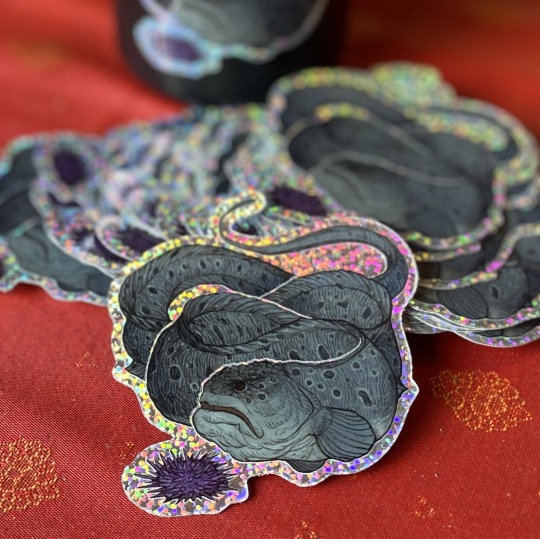
I’m selling stickers! Very limited run to start, as this is something of an experiment, but if glittery wolf eels inspire you, be sure to claim one before they’re gone!
If they DON’T inspire you yet, here are some wolf eel fun facts:
1. Wolf eels typically mate for life, though not until around 7 years of age. However, they may start seeing other eels and spending time in each other’s hides as young as 5.
2. Wolf eels are not true eels (order anguilliformes)! Yet they share many convergent features such as reduced scales, snakelike bodies, and swimming by tipping their body sideways while undulating in a wave motion.
3. Every wolf eel has a unique pattern of spots, that biologists can use to recognize individuals akin to a fingerprint.
4. Baby wolf eels are bright orange! They’re also much more active, spending the first few months of life swimming free in the water column and the next few years searching the sea floor for their forever-home. (Adults tend to be homebodies, unless they’re actively hunting)
5. Wolf eels have powerful jaws packed with molar-like teeth that they use to crack hard and spiny invertebrates. Not even sea urchins are safe!
442 notes
·
View notes
Text
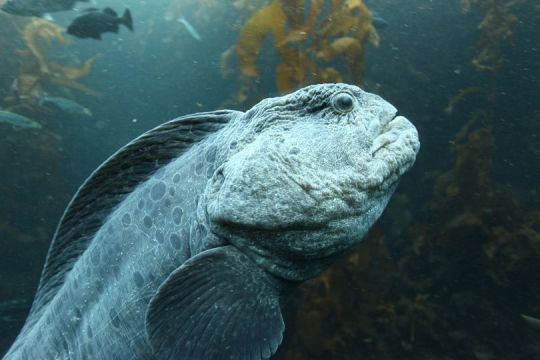
Wolf Eel (Anarrhichthys ocellatus), family Anarhichadidae, found in the North Pacific
photograph via: Monterey Bay Aquarium
344 notes
·
View notes
Text
It’s Wet Beast Wednesday and today’s topic is Anarrhicthys ocellaus, the wolf eel. Despite the name and long-skinny body, they aren’t eels (I’ll get around to true eels eventually, I promise), they’re actually one of the wolf fish, a family of 5 species, the rest of which look less eely. These fish are most famous on the internet for being ugly, which is a bit rude. Sure, they may look a bit like Popeye the Sailor Man, but that’s no reason to be insulting. I think they’re kind of cute, in a pug sort of way.
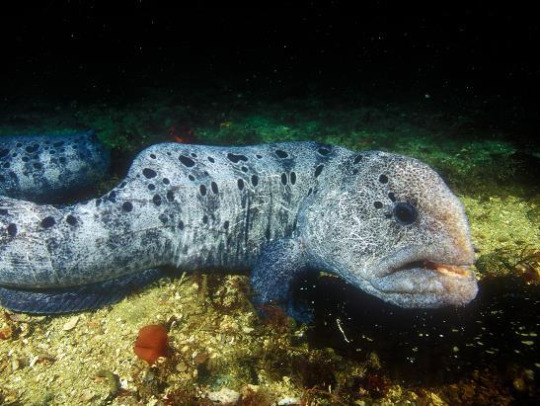
(Image: a wolf eel)
Wolf eels live in cold pacific waters in the Sea of Japan up into the Sea of Okhotsk, across the Aleutian islands, and down to southern California. Their long, slender bodies can grow up to 2.4 meters (about 8 feet) long ang weigh up to 18.4 kg (41 pounds), making them both longer and heavier than some children. Like moray eels, they prefer living in caves and crevices, often only sticking their heads out to look for food. Many will find a suitable cave as a juvenile and never leave unless forced out by a larger wolf eel or another cave-dweller like the giant pacific octopus. Wolf eels have a layer of mucus covering their bodies that helps protect from disease. Their scales are small and imbedded in their skin, giving their skin a leathery appearance. Each individual has a unique pattern of spots on their head, which can be used to identify them.

(Image: a wolf eel)
Wolf eels have large and powerful jaws and well as notable teeth. They are heterodonts, meaning they have teeth of different shapes that serve different functions. This is actually somewhat uncommon amongst animals. Amongst extant vertebrates, only mammals, some fish, and snakes have this feature. Wolf eels have molars and canines. In fact, the prominent canines of the wolf fish family is the origin of their name. Wolf eels use their hard molars and powerful jaws to crush and eat hard food. Their preferred diet includes sea urchins, sand dollars, crustaceans, and bivalves. They rarely eat soft food and aquarium specimens that have been fed soft food extensively can show poor dental health.

(image: a wolf eel monching on eating an urchin)
If you need more reasons to not insult them, wolf eels are romantics and model parents. They are monogamous and mated pairs will live and mate together for life. These pairs have a unique form of mating behavior. The male will nuzzle the female with his head and coil around her while she lays her eggs (up to 10,000 at a time), which he will then fertilize. Afterwards, the female will coil around the eggs to shape them into a ball She will occasionally rotate and massage the egg ball to make sure all the eggs are getting exposed to oxygenated water. When both are in the cave, the female will coil around the eggs to protect them while the male coils around her for more protection. Both parents share egg protecting duties, with only one leaving to go eat at a time. Once the eggs hatch, the larvae will leave the nest and move to the open ocean to grow. Juveniles live in the open ocean and have a different diet than adults. They are more active predators who use their canines to attack and eat small fish and fish larvae. After a few years, they will make their way back to shallower waters to take up their adult lifestyles. They become sexually mature at around 7 years old, though some will par up with their future mate as early as age 4. In addition, juveniles are bright orange with purple spots. They become darker as they age, eventually becoming fully grey.

(image: a pair of wolf eels protecting their eggs, the yellowish ball on the middle)
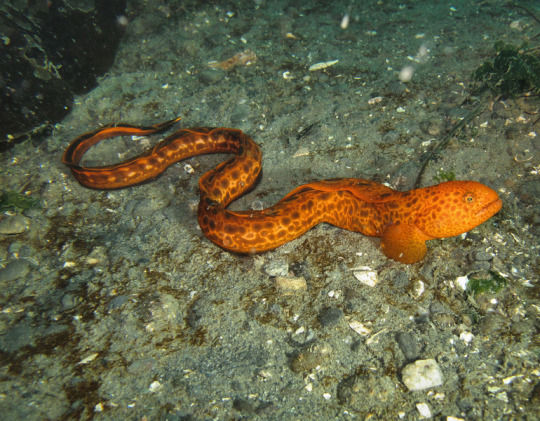
(image: a juvenila wolf eel)
Wolf eels are rather curious and even playful animals. In places with lots of human activity, they can become used to divers. In fact, they can even become friendly with divers, sometimes coming out to play with them and being happy to receive chin scratches. In many places, divers can hand-feed the wolf eels. This is controversial as it can disincentivize natural hunting behavior and ignorant divers may feed the eels the food that is bad for them. Wolf eels are very rarely aggressive, but they can deliver very painful bites if provoked.

(image: a wolf eel and a diver)
Wolf eels are classified as “least concern” by the IUCN, meaning they are in no danger of extinction. Still, threats to them include bycatch and pollution. They are rarely targeted for fishing today, but in the past, they were targeted by a few Native American tribes. In these, they were considered to be sacred “doctorfish” and were only eaten by healers, in the belief it would enhance their healing abilities.
UPDATE: after doing some digging regarding the usage of the fish by Native American tribes I found that everyone who makes this claim seems to reference the book "Probably More Than You Want to Know About the Fishes of the Pacific Coast" by Milton S. Love, which itself cites a book from either 1868 or 1870 titled "The Indians of Cape Flattery, at the entrance to the Strait of Fuca, Washington Territory" by James Swan. The book specifically discusses the Makah people. I'm a bit skeptical about the source so take those claims with a grain of salt.

(image: a wolf eel sticking out of a rock)
525 notes
·
View notes
Note
what’s your opinion on wolf eels i personally love them :3
I love wolf eels!!!! Super cool fish!!!! Very very important to the ecosystem because they control sea urchin and crustacean populations and they're so interesting, they have antifreeze blood!!!! I love love wolf eels and they're underrated to be honest. They're not really eels despite the name but they should be up there I think. Mostly I see them talked about in relation to their appearance



How could you say you dislike cutie patooties like this?
#the middle one wouldve made rounds during the “derp” “kawaii potato” “llamocado” era of the internet#asks#x-xvampyrexgutzx-x#wolf eel
126 notes
·
View notes
Text

A juvenile wolf-eel (Anarrhichthys ocellatus) in Puget Sound, Washington, USA
by Scott Okumura
#wolf eel#eels#bony fish#fish#anarrhichthys ocellatus#anarrhichthys#Anarhichadidae#Scorpaeniformes#actinopterygii#chordata#wildlife: washington#wildlife: usa#wildlife: north america
109 notes
·
View notes
Text
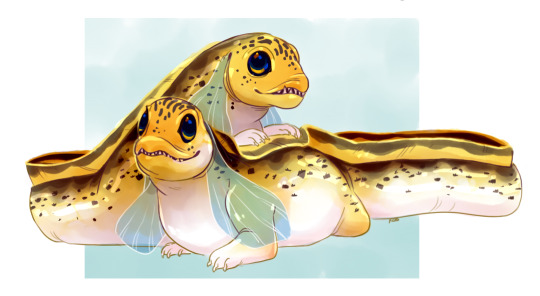
You see no chests overflowing with treasure in the sea dragon's lair, there are only salvaged shipwreck bits and two chubby little creatures splashing around in a shallow nest pool.
over on patreon Gay Spaceship requested some eel-dogs so here are two sunshiny wolf eel cubs! here's hoping the parents are either super friendly or far away.
1K notes
·
View notes
Text
Which one are you?
122 notes
·
View notes
Text


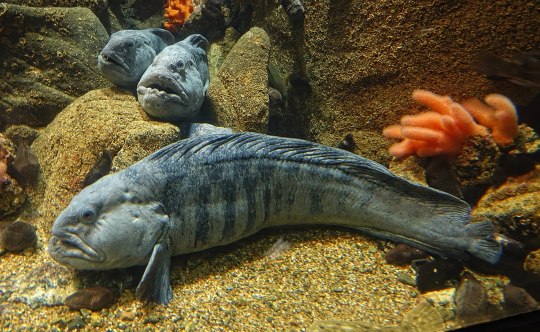



The Atlantic wolffish (Anarhichas lupus), also known as the seawolf, Atlantic catfish, ocean catfish, devil fish, wolf eel, woof or sea cat, is a marine fish of the wolffish family Anarhichadidae, which is native throughout the North Atlantic Ocean with the densest populations being occurring at Georges Bank, the Gulf of Maine, the Irish Sea, Denmark Strait, and White Sea. As a benthic dwelling cold water species, the Atlantic wolffish are primarily stationary fish which primarily inhabit sea floor nooks and caves around 66 to 1,640ft (20 to 500m) in depth. They prefer temperatures of −1 to 11 °C (30–52 °F). To survive such cold temperatures there blood contains a natural antifreeze. Atlantic wolfish are uniquely adapted to use their strong jaws to crush and crack open the shells of molluscs, crustaceans, and echinoderms, and are a vital predator of sea urchins, green crabs, and starfish. Reaching up to 5ft (1.5m) in length and 40lbs (18kg) in weight, The Atlantic wolffish has retained the bodily form and general external characteristics of small blennies albeit just on a much larger scale. Its body is long, subcylindrical in front, compressed in the caudal portion, smooth and slippery, the rudimentary scales being embedded and almost hidden in the skin. Atlantic wolffish vary in color, usually seen as purplish-brown, a dull olive green, or blueish gray. An even dorsal fin extends the whole length of the back, and a similar fin from the vent to the caudal fin, as in blennies. The pectorals are large and rounded and the pelvic fins are entirely absent. Its obtuse, eel-like body type makes the fish swim slowly, undulating from side to side, like an eel.The Atlantic wolffish's distinguishing feature, from which it gets its common name, is its extensive teeth structure with Both the lower and upper jaws are armed with four to six fang-like, strong, conical teeth. Unlike most fish, Altantic wolffish perform internal fertilization and form close mated pairs in which both parents care for and guard there nest of eggs which they build out of sea weed and stones. After hatching the young will stay with there parents for up to four months, until they are strong enough to gain independence. Under ideal conditions an atlantic wolffish may reach sexual maturity at around 6 years of age and may live upwards of 20.
#pleistocene#pleistocene pride#pliestocene pride#pliestocene#cenozoic#atlantic#atlantic wolffish#wolf#wolffish#fish#sea wolf#wolf eel#sea cat#sea catfish#atlantic catfish#woof
16 notes
·
View notes
Text
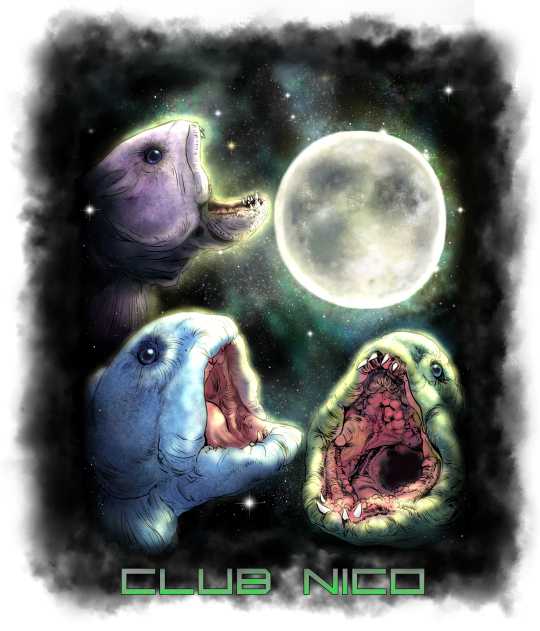
It's been a while since I uploaded new art, so here's another one of the designs saved up for my in-progress merch store. It's the classic Three Wolf Moon shirt, with an icthyological twist featuring some of my favorite sea creatures--the adorably ugly wolf eel.
#wolf eel#wolf fish#atlantic wolf fish#eels#fish#sea creatures#marine life#sea life#marine biology#wolves#3 wolf moon#three wolf moon#club nico#portfolio#color.art#digital.art
68 notes
·
View notes
Text
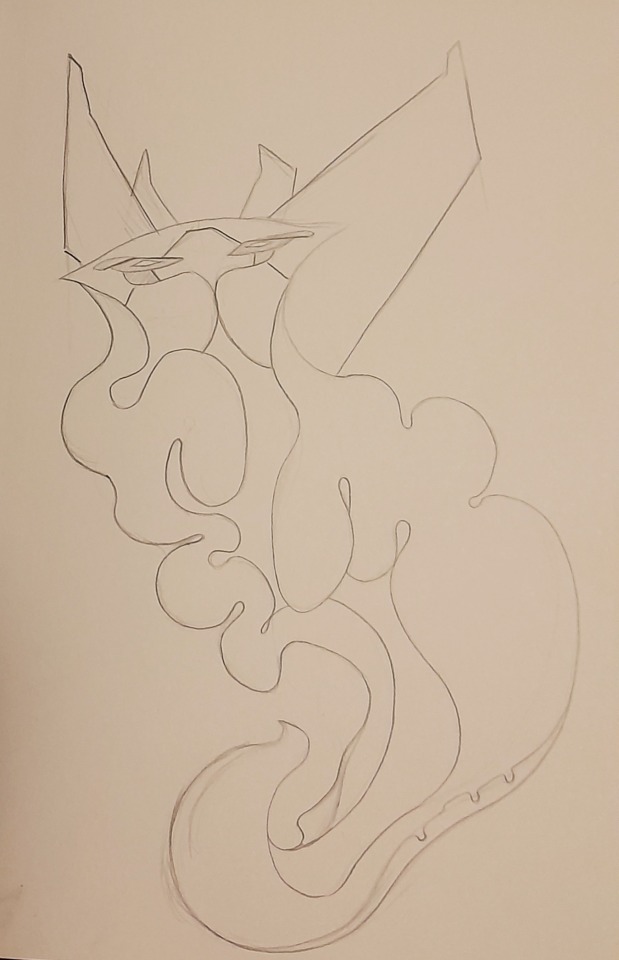

This is so silly. Silly transformer sea creature sketches.
Starscream the spanish dancer flat worm and Megatron wolf eel.
#Eel#transformers#tf#art#macadams#spanish dancer#flat worms#Wolf eel#traditional art#Sea creatures au#sketch
3 notes
·
View notes
Note
in your pirate/shapeshifter AU, is Wolffe a wolf eel?
I wasn´t sure what he´d be, but after googling what the absolute hell a wolf eel is, ABSOLUTELY YES, NO NOTES.
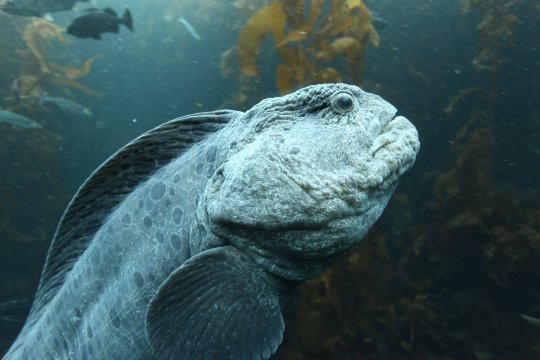
Look at this magnificant grump.
2 notes
·
View notes
Text
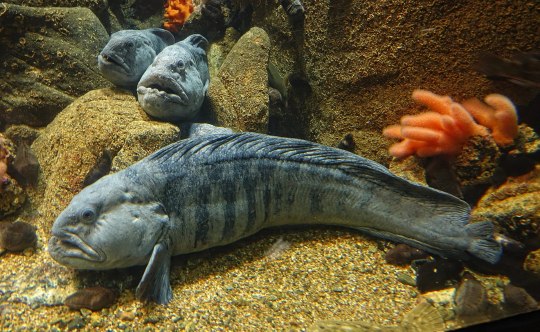
Atlantic Wolffish (Anarhichas lupus), family Anarhichadidae, found in the North Atlantic
photograph by Bjørn Christian Tørrissen
401 notes
·
View notes
Text
🐟 Fishuary 2024 Day Nineteen: Arctic Ocean 🐟
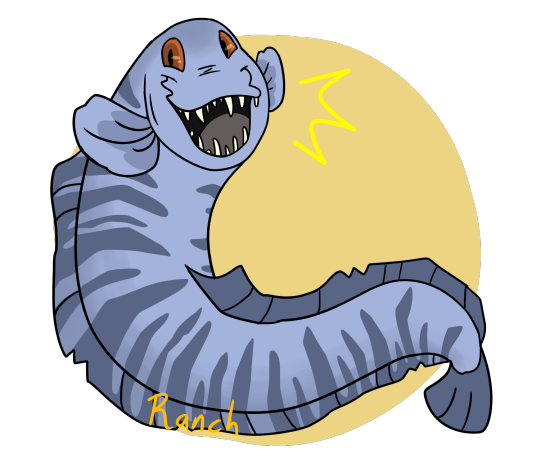
For this prompt I drew the Atlantic wolffish (Anarhichas lupus), which despite the name also inhabits the Arctic Ocean. They have just the cutest face!!!!
@fish-daily
32 notes
·
View notes
Photo


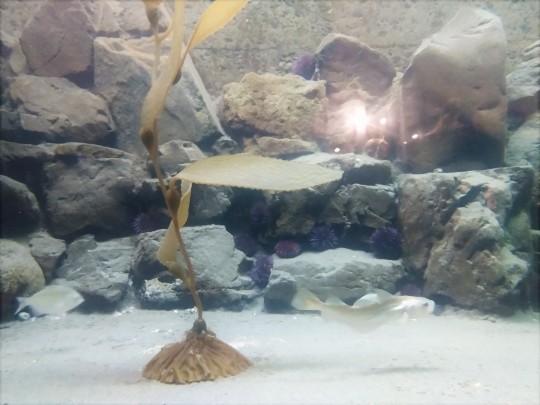

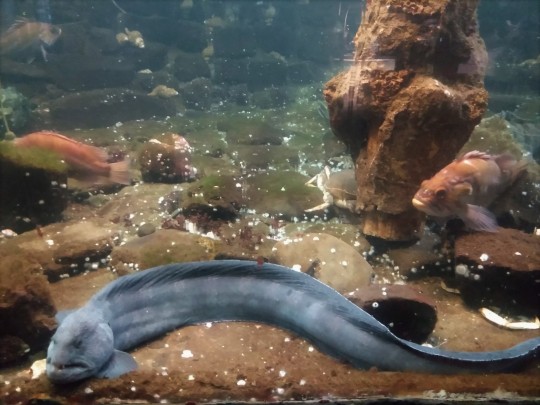
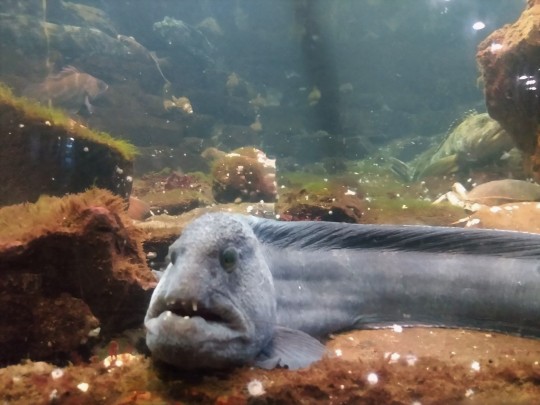

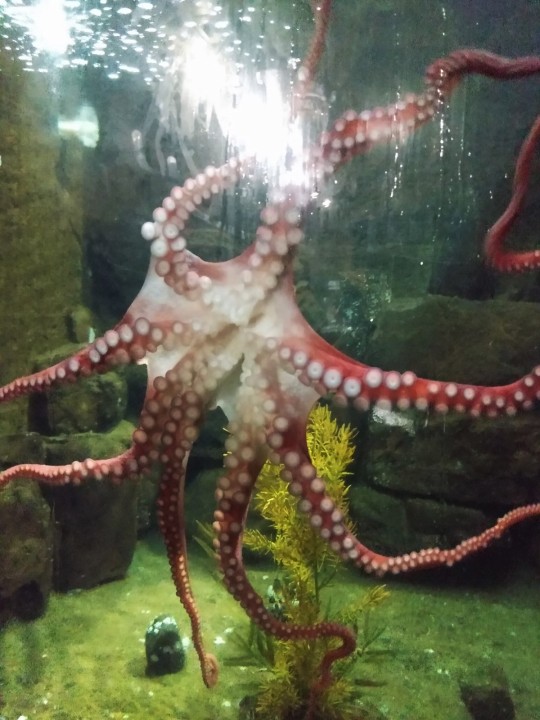

Seaside Aquarium
24 notes
·
View notes
Text


wolf eels beatrice (left) and betty (right)
38 notes
·
View notes
Text
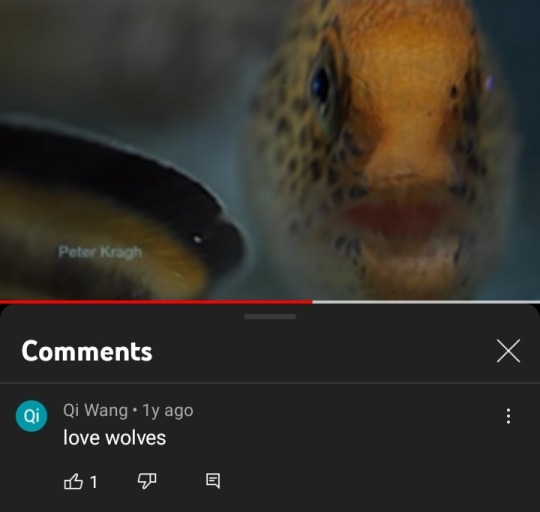


source 1 / source 2 / source 3
11 notes
·
View notes